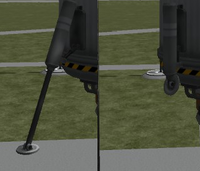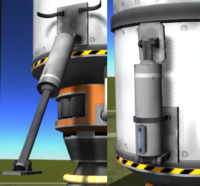Difference between revisions of "LT-2 Landing Strut"
From Kerbal Space Program Wiki
Thecoshman (talk | contribs) |
Thecoshman (talk | contribs) m (→Description: Removed this empty section) |
||
| Line 21: | Line 21: | ||
== Usage == | == Usage == | ||
The '''LT-2 Landing Strut''' is used as a landing support when landing vertically. It is connected radially and extends with the G key (Default). While the non-deployable version has 20 times less mass, it is also less stable and is better suited for lighter and smaller landers than its deployable counterpart. The deployable '''LT-2 Landing Strut''' is also much longer when extended, making it suitable for landers with larger engines. | The '''LT-2 Landing Strut''' is used as a landing support when landing vertically. It is connected radially and extends with the G key (Default). While the non-deployable version has 20 times less mass, it is also less stable and is better suited for lighter and smaller landers than its deployable counterpart. The deployable '''LT-2 Landing Strut''' is also much longer when extended, making it suitable for landers with larger engines. | ||
| − | |||
| − | |||
| − | |||
== Changes == | == Changes == | ||
Revision as of 17:51, 24 November 2012
Template:PartboxThe "LT-2 Landing Stut" is primarily used to land on Mun, Minmus and other celestial bodies. It comes in 2 versions, a deployable and a non-deployable one.
Usage
The LT-2 Landing Strut is used as a landing support when landing vertically. It is connected radially and extends with the G key (Default). While the non-deployable version has 20 times less mass, it is also less stable and is better suited for lighter and smaller landers than its deployable counterpart. The deployable LT-2 Landing Strut is also much longer when extended, making it suitable for landers with larger engines.
Changes
- Added deployable version
- Initial Release

